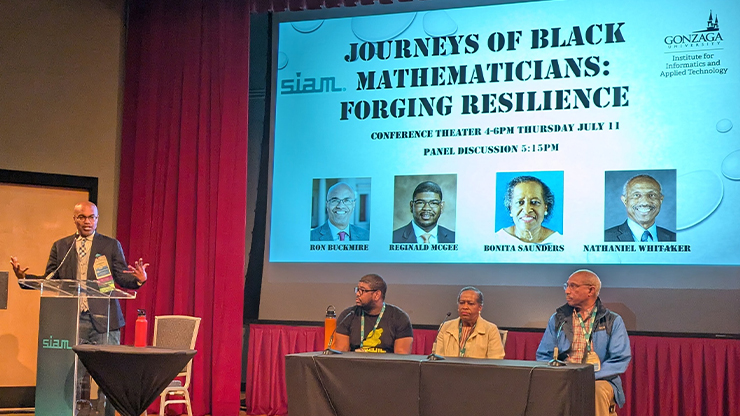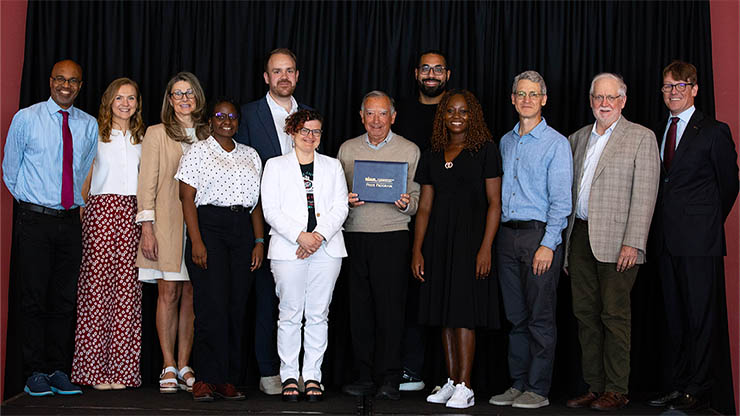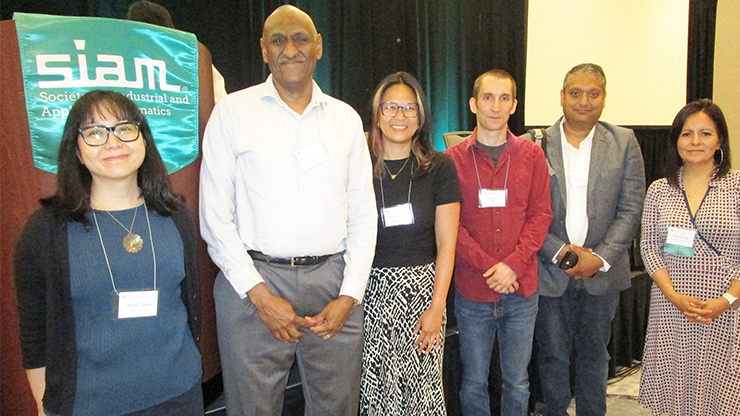Career Opportunities Panel at AN24 Provides Comprehensive Look at the Job Market
As students complete coursework, pursue internships, and work towards their degrees, they must make important decisions about their future careers. Specifically, individuals who are studying applied mathematics, computational science, data science, and other adjacent fields typically have to choose between employment in academia, industry, or the national laboratories. Though these sectors do share some similarities, each one offers its own set of characteristics, advantages, and challenges.
During the 2024 SIAM Annual Meeting—which took place in Spokane, Wash., this July—a panel of applied mathematicians, computer scientists, and engineers at varying stages of professional development shared their insights about career prospects within these three settings. Jeffrey Hittinger of Lawrence Livermore National Laboratory (LLNL) chaired the session, which featured panelists Manuchehr Aminian of California State Polytechnic University, Pomona; Ron Buckmire of Marist College (SIAM’s Vice President for Equity, Diversity, and Inclusion); Cosmin Ionita of MathWorks; Shelby Lockhart of AMD; Jason Torchinsky of Sandia National Laboratories; and Carol Woodward of LLNL (SIAM’s President-Elect).

After summarizing their respective career trajectories, the panelists began by reflecting on their time as graduate students. For Torchinsky, graduate school was about finding someone that they wanted to work with, rather than a subject that they wanted to work on. Torchinsky encouraged students to maintain authority over their pursuits and ensure that the projects of potential advisors align with their own interests and research goals. Lockhart echoed this sentiment. “I wish I had known that it was my Ph.D.,” she said, admitting that she switched advisors after two years in favor of a project for which she was better suited. “Advocate for yourself.”
Aminian similarly recalled that upon starting graduate school, he did not yet have a sense of agency over his own career. He urged students to take advantage of travel grants from SIAM and other societies in order to attend events with a greater sense of independence, network with junior and senior researchers, and explore trending topics. Buckmire seconded the importance of these funding opportunities. “There is a fair amount of money out there—generally supported by the National Science Foundation (NSF)—to expose grad students to lots of different experiences and help them make decisions about what paths they want to pursue,” he said. “The Mathematical Sciences Institutes are a great example of that.”
Woodward’s personal experiences speak to the value of internships and summer research programs. Prior to earning her undergraduate degree, she knew that she did not want to become a professor; instead, student positions at Oak Ridge National Laboratory and Pacific Northwest National Laboratory cemented her penchant for the national labs. Ionita was also certain that he wanted to utilize applied mathematics in a nonacademic setting. After defending his thesis, he applied for an available role within MathWorks’ core math team. “It was a nice opportunity where I could continue doing math — not just random coding, but programming with a purpose,” Ionita said of his now 10-year career at MathWorks.
Next, the panelists detailed the distinctions between the work environments in academia, industry, and national labs. Buckmire explained that the key “phase transition” in academia occurs with the acquisition of tenure, as faculty expend a lot of energy preparing for tenure and constructing their portfolios to meet rigorous standards. “Once you pass that phase transition and you’re tenured, it can actually be a pretty difficult situation,” he said. “You have this long expanse of being at an institution for as long as you want, and you can decide how to engage and what to engage in. It can take a while to figure out what the next frontiers will be.”
Anyone who is seeking a position in academia should be passionate about teaching and mentoring, since these duties comprise a significant portion of an academic career. Additionally, the level of autonomy and flexibility in academia is much greater than in industry or the national laboratories, and there is often no one “right” way to do things. For instance, Buckmire’s 30-year stint at Occidental College—he moved to Marist just last month after accepting a position as dean of the School of Computer Science and Mathematics—included a foray into higher education administration and two “tours of duty” as an NSF program director.
While much academic work is solo, the vast majority of industry and national lab projects are collaborative. “Everything we do is in teams,” Woodward said. The interdisciplinary nature of labs also means that mathematics research is situated within the broader context of science and engineering, with the ultimate goal of delivering scientific knowledge to society. Woodward advised interested candidates to research each laboratory in advance. “There are different cultures at every lab,” she said. “Different topics are emphasized based on the applications that are most active.”
Woodward also noted the significance of coding, especially given the national labs’ collective emphasis on efficiency and high-performance computing. “Impact happens through code,” she said. “The ability to translate a new algorithm into efficient code is really important.” Lockhart agreed, adding that coding is just as valuable in industry. She explained that employees must know how to build all types of code, evaluate performance on systems that may or may not yet exist, and connect their work to the organization’s objectives. “Industry is driven by profit,” Lockhart said. “You have to be able to tie it back to the company’s mission, which is making money.”
Communication is similarly critical in industry, especially since projects are meant to produce tangible outputs that benefit the customer. Aminian encouraged listeners to always consider the background and perspectives of the people with whom they are communicating, as many exchanges will involve customers or recipients who may be literate in science but not in applied mathematics specifically. Ionita affirmed the value of this advice. “At MathWorks, you have to encapsulate deep technical concepts into something that’s easy to use for people who don’t necessarily know what they’re using,” he said. “You need to eliminate as many parameters as possible and still make it work for a ton of people.”

Conversation then turned to strategies for self-promotion when applying for positions as a junior scientist. Lockhart reminded the audience that all types of experiences—even unofficial side projects—are worthy of mention because they demonstrate initiative, a willingness to learn, and the ability to master new concepts. “If you didn’t do your thesis on optimization but have done some software optimization, make sure that it’s visible so people know what you know,” she said. “In industry, self-learning is just as credited as traditional learning.” Aminian suggested that early-career researchers maintain an active presence on GitHub, list previous projects on their personal websites, demonstrate proficiency in Linux-like environments, and use their code to generate figures for their portfolios. Ionita likewise encouraged job seekers to readily share their code, despite any imperfections. “People won’t have the expectation of grad school code being bulletproof,” he said. “It’s more important to get it out there and show it.”
Torchinsky advised anyone who is looking for an internship, postdoctoral placement, or permanent position to promote themselves whenever possible. While in the market for employment as a postdoc, they always ended their conference presentations with slides that advertised their availability. As a result, prospective employers often approached Torchinsky after the talk to ask for their CV or request an interview, since they had just seen a concrete example of their work in action. “There are individuals in this room who are looking to hire people,” Torchinsky said, noting that SIAM conferences are great places to make connections.
When asked how to best prepare for management and leadership positions, Woodward stated that LLNL—like many other organizations—had provided leadership training in the form of classes. One lesson in particular stuck with her: the idea that everyone is a leader in some capacity, regardless of their title. “We all have autonomy over our careers and organizations to some degree,” Woodward said. “I took a lot of that to heart.” It is also important to acknowledge the existence of learning curve for all new responsibilities. Whenever Woodward accepts a new leadership role, she connects with experienced individuals who can mentor her in the duties of that position. As SIAM’s current President-Elect, she has been talking to past SIAM presidents about difficulties that may arise and how to best address them. “Every leadership role has challenges that require consideration of issues at a level I wasn’t thinking before,” she said. “It doesn’t mean that I can’t think about it, it just means that I haven’t been exposed to what those issues are.”
The panel session concluded with a brief discussion about effective time management when balancing multiple projects. Lockhart maintains a personal priority queue, rotates through deadline-driven items at the top of her list, and designates certain time blocks for specific responsibilities. Buckmire affirmed the benefits of this strategy but urged people in team-oriented settings to also pay attention to the bandwidth of their collaborators in order to fairly distribute the workload and prioritize tasks based on availability.
Time management and project allocation become much easier when the goals of researchers and their employers closely align. Woodward admitted that while she has always struggled somewhat to prioritize simultaneous tasks, her positive relationship with LLNL simplifies the process. “You should be picking the things more often that are most important to the organization because that’s what’s going to keep you in the job,” she said. “Every day I come in and have to make choices. But I love the national lab environment and I get to work on really challenging problems on which I feel that I can make some progress.”
About the Author
Lina Sorg
Managing editor, SIAM News
Lina Sorg is the managing editor of SIAM News.

Stay Up-to-Date with Email Alerts
Sign up for our monthly newsletter and emails about other topics of your choosing.






